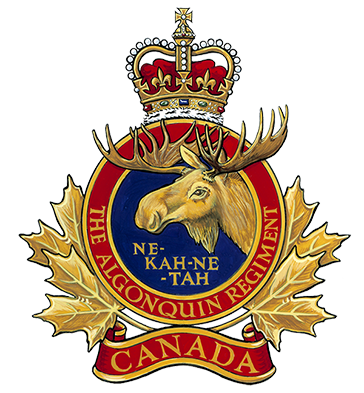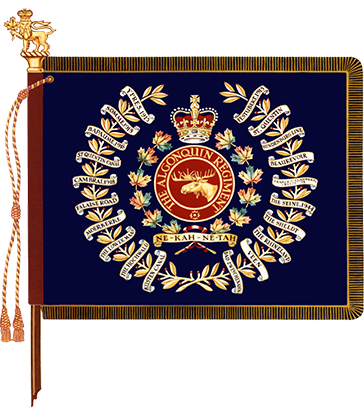The Algonquin Regiment
The official lineage of The Algonquin Regiment infantry regiment.

Badge
Description
Azure a bull moose's head and neck Or attired proper issuant from the sinister flank, in base the Motto in letters Or, all within an annulus Gules edged and inscribed THE ALGONQUIN REGIMENT in letters Or, ensigned by the Royal Crown proper and flanked on each side by maples leaves Or issuant from a scroll Gules edged and inscribed CANADA in letters Or.
Symbolism
The maple leaves and the word "CANADA" represent service to Canada, and the Crown, service to the Sovereign. The bull moose is a symbol of the region in which the regiment was raised. "THE ALGONQUIN REGIMENT" is the regimental title and "NE-KAH-NE-TAH" is the motto of the regiment.
Motto
NE-KAH-NE-TAH (Let us lead)
March
“We Lead, Others Follow”
Alliance
British Army
The Rifles
Regimental colour

Camp flag

Battle honours
The First World War
YPRES, 1915, '17; FESTUBERT, 1915; ARRAS, 1917; HILL 70; SOMME, 1918; St. Quentin; Bapaume, 1918; HINDENBURG LINE; Epéhy; St. Quentin Canal; Beaurevoir; Cambrai, 1918; FRANCE AND FLANDERS 1915, 1917-18.
The Second World War
FALAISE; Falaise Road; The Laison; Chambois; The Seine, 1944; Moerkerke; THE SCHELDT; Breskens Pocket; The Lower Maas; THE RHINELAND; The Hochwald; Veen; Küsten Canal; Bad Zwischenahn; NORTH-WEST EUROPE, 1944-1945.
South-West Asia
AFGHANISTAN
Lineage
This Reserve Forces regiment originated on 1 July 1900 and incorporates the following regiments.
The Algonquin Regiment originated in Sault Ste. Marie, Ontario on 1 July 1900, when the '97th Regiment of Rifles' was authorized to be formed.Footnote 1 It was redesignated: '97th Regiment "Algonquin Rifles"' on 1 June 1903;Footnote 2 'The Algonquin Rifles' on 1 May 1920;Footnote 3 and 'The Algonquin Regiment' on 15 February 1929.Footnote 4 On 15 December 1936, "B", "C" and "D" Companies of the regiment were amalgamated with 'The Northern Pioneers' (see below), retaining the same regimental designation.Footnote 5 It was redesignated: '2nd (Reserve) Battalion, The Algonquin Regiment' on 7 November 1940;Footnote 6 and 'The Algonquin Regiment' on 15 February 1946.Footnote 7 The regiment was converted to armour and redesignated: 'The Algonquin Regiment (26th Armoured Regiment)' on 1 October 1954;Footnote 8 and 'The Algonquin Regiment (RCAC)' on 19 May 1958.Footnote 9 On 19 March 1965, it was converted to infantry and redesignated 'The Algonquin Regiment'.Footnote 10
Notes:
Upon redesignation as The Algonquin Rifles on 1 May 1920 (see above), it was organized as a three battalion regiment with the 1st Battalion (159th Battalion, CEF) on the Non Permanent Active Militia order of battle, and the 2nd Battalion (228th Battalion, CEF) and 3rd Battalion (256th Battalion, CEF) on the Reserve order of battle. The reserve units were disbanded on 14 December 1936 (GO 3/37).
The Algonquin Rifles were disbanded for the purpose of reorganization on 1 June 1922 and reorganized the same day(GO 120/22). This change was administrative and does not affect the lineage of the regiment.
The Algonquin Regiment was disbanded for the purpose of reorganization and amalgamation on 14 December 1936 and reorganized the next day (GO 189/36).This change was administrative and does not affect the lineage of the regiment.
On 15 December 1936, 'The Sault Ste. Marie Regiment' was amalgamated with the 'Headquarters' and 'A Company' of 'The Algonquin Regiment' and redesignated 'The Sault Ste. Marie and Sudbury Regiment (MG)', now the '49th Field Artillery Regiment, RCA' (GO 189/36).
On 4 May 1951, the regiment mobilized two temporary Active Force companies, designated "E" and "F" (CAO 110-2, Pt 'B', Supp Issue No. 245/51 and SD 1 Letter No. 4237, 5 May 1951). "E" Company was reduced to nil strength upon its personnel being absorbed into the '1st Canadian Infantry Battalion' for service in Germany with the North Atlantic Treaty Organization (SD 1 Letter No. 4365, 12 November 1951). It was disbanded on 29 July 1953 (CAO 78-2, Pt 'B', Supp Issue No. 352/53). "F" Company was initially used as a reinforcement pool for "E" Company. On 15 May 1952, it was reduced to nil strength, upon its personnel being absorbed by the newly formed '2nd Canadian Infantry Battalion' for service in Korea with the United Nations (SD 1 Letter No. 4452, 22 April 1952 and CAO 110-2, Pt 'B', Supp Issue No. 283/52). "F" Company was disbanded on 29 July 1953 (CAO 78-2, Pt 'B', Supp Issue No. 352/53).
The Northern Pioneers originated in Parry Sound, Ontario on 1 September 1903, when the '23rd Regiment "The Northern Fusiliers"' was authorized to be formed.Footnote 11 It was redesignated: '23rd Regiment "The Northern Pioneers"' on 1 January 1904;Footnote 12 and 'The Northern Pioneers' on 1 May 1920.Footnote 13 On 15 December 1936, it was amalgamated with 'The Algonquin Regiment', as above.
Notes:
Upon redesignation as The Northern Pioneers on 1 May 1920 (see above), it was organized as a two battalion regiment with the 1st Battalion (162nd Battalion, CEF) on the Non Permanent Active Militia order of battle, and the 2nd Battalion (122nd Battalion, CEF) on the Reserve order of battle. The reserve unit was disbanded on 14 December 1936 (GO 3/37).
The Northern Pioneers were disbanded for the purpose of reorganization on 15 February 1921 and reorganized the same day (GO 118/21). This change was administrative and does not affect the lineage of the regiment.
The Northern Pioneers were disbanded for the purpose reorganization and amalgamation on 14 December 1936 (GO 189/36). This change was administrative and does not affect the lineage of the regiment.
Perpetuations
'122nd', '159th', '162nd', '228th' and '256th "Overseas" Battalion(s), CEF'
Headquarters Location
North Bay, Ontario
Operational history
The First World War
Details of the 23rd Regiment "The Northern Pioneers" were placed on active service on 6 August 1914 for local protection duties.Footnote 14
The 122nd Battalion, which was authorized on 22 December 1915 as the '122nd "Overseas" Battalion, CEF',Footnote 15 embarked for Britain on 2 June 1917.Footnote 16 Its personnel were absorbed by the 'Canadian Forestry Depot, CEF' on 10 June 1917 to provide reinforcements.Footnote 17 The battalion was disbanded on 1 September 1917.Footnote 18
The 159th Battalion, which was authorized on 22 December 1915 as the '159th "Overseas" Battalion, CEF',Footnote 19 embarked for Britain on 31 October 1916.Footnote 20 Its personnel were absorbed by the '8th Reserve Battalion, CEF' on 20 January 1917 to provide reinforcements for the Canadian Corps in the field.Footnote 21 The battalion was disbanded on 27 July 1917.Footnote 22
The 162nd Battalion, which was authorized on 22 December 1915 as the '162nd "Overseas" Battalion, CEF',Footnote 23 embarked for Britain on 31 October 1916.Footnote 24 Its personnel were absorbed by the '3rd Reserve Battalion, CEF' and the '4th Reserve Battalion, CEF' on 4 January 1917 to provide reinforcements for the Canadian Corps in the field.Footnote 25 The battalion was disbanded on 30 August 1920.Footnote 26
The 228th Battalion, which was authorized on 15 July 1916 as the '228th "Overseas" Battalion, CEF',Footnote 27 embarked for Britain on 16 February 1917.Footnote 28 It was redesignated '6th Battalion, Canadian Railway Troops, CEF' on 8 March 1917.Footnote 29 The battalion landed in France on 3 April 1917,Footnote 30 where it provided railway construction support on the British Western Front until the end of the war.Footnote 31 The battalion was disbanded on 23 October 1920.Footnote 32
The 256th Battalion, which was authorized on 1 May 1917 as the '256th "Overseas" Railway Construction Battalion, CEF',Footnote 33 embarked for Britain on 28 March 1917.Footnote 34 It was redesignated '10th Battalion, Canadian Railway Troops, CEF' on 30 May 1917.Footnote 35 It disembarked in France 19 June 1917,Footnote 36 where it provided railway construction support on the British Western Front until the end of the war.Footnote 37 The battalion was disbanded on 23 October 1920.Footnote 38
The Second World War
The regiment mobilized 'The Algonquin Regiment, CASF' for active service on 24 May 1940.Footnote 39 It was redesignated '1st Battalion, The Algonquin Regiment, CASF' on 7 November 1940.Footnote 40 The regiment served in Canada in a home defence role as part of the 20th Infantry Brigade, 7th Canadian Division and in Newfoundland from 7 February 1942 to 6 February 1943.Footnote 41 It embarked for Britain on 11 June 1943 and landed in France on 25 July 1944, as part of the 10th Infantry Brigade, 4th Canadian Armoured Division, and it continued to fight in North-West Europe until the end of the war.Footnote 42 The overseas battalion was disbanded on 15 February 1946.Footnote 43
South-West Asia
From 2002 to 2014, the Algonquin Regiment reinforced various CAF units deployed to Afghanistan.Footnote 44
Page details
- Date modified: